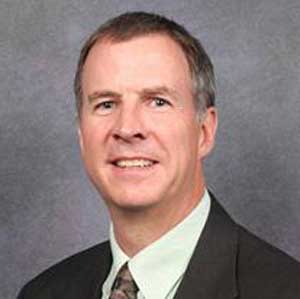William Sullivan, M.D., is vice chair of Physical Medicine and Rehabilitation (PM&R) at Vanderbilt University Medical Center and director of the PM&R residency program. As the newly appointed president of the North American Spine Society (NASS), Sullivan joined Discoveries to discuss the current state of spine medicine and his outlook for the future.
Full Spectrum Care
Discoveries: You’re not the first non-surgeon to lead the NASS. What is the thinking today about surgical versus non-surgical spine intervention?
Sullivan: Like many other aspects of health care, spine care is taking a multidisciplinary approach. In fact, we’ve probably been doing it a lot longer than most other specialties. Spine care often used to begin with treating the patient based what you find on an MRI. We know that does not always show where the pain is located and the treatment is not always surgery or another intervention. But it’s not about surgery versus non-surgery, an either-or, or us versus them; it’s breaking down the barriers and taking part in patient care through the entire continuum.
“It’s not about surgery versus non-surgery, an either-or, or us versus them.”
Effective spine care incorporates orthopaedic surgeons and neurosurgeons, PM&R specialists, anesthesiologists, neurologists, other pain specialists, chiropractors, physical therapists, psychologists, radiologists and others. In the ideal situation, you would want non-surgeons doing the non-surgical care. The reason I have been involved with NASS is that all these people come together in one organization for education, research and advocacy.
Role of PM&R
Discoveries: That approach sounds like it requires a great deal of coordination among specialists. What is the role of PM&R?
Sullivan: You often need a specialist in charge of management; ideally, they can be the person who evaluates the patient, does the workup, manages nonoperative treatment, and refers to the surgeon patients who are appropriate surgical candidates.
Many PM&R specialists fall into this role; having that skill set is an added value to the overall evaluation. Identifying which patients need medical or even psychological treatment prior to surgery maximizes the likelihood of a successful outcome. This usually takes more time than a typical surgical practice would be used to. For instance, some studies have shown that smoking dramatically impacts spinal surgery outcomes with longer operating room times and increased blood loss. Obesity and prior opioid use may be other factors that impact surgical outcomes. Having someone assist the surgical team in the management of these issues is likely to improve care.
Surgical vs. Non-Surgical Costs
Discoveries: Let’s talk about costs. How does this multispecialty model impact reimbursement?
Sullivan: Reimbursement is a big question; studies have looked at cost drivers in a lot of scenarios. For instance, some providers may order more MRIs than might be needed. Other studies have found that when you involve PM&R in the process, there may be cost savings. Obviously, there are savings when you avoid surgery and you’re minimizing unnecessary medications like opioids. However, it can go back and forth. Imaging, injections, and physical therapy can all add to costs if used indiscriminately. We may need more appropriate use of physical therapy and chiropractic treatment so there’s not an overutilization of those treatments. Better managed overall care is the key.
“Studies have found that when you involve PM&R in the process, there may be cost savings.”
Recent studies involving data-mining techniques have produced conflicting results that may be skewed to surgical intervention versus non-surgical intervention, or maximal nonoperative therapy (MNT). We should be careful in reviewing the literature that we consider coding anomalies, cost and outcomes of surgery, post-surgery costs, and who recommended/performed the MNT prior to making assumptions that non-surgical care is not cost-effective. It benefits us all as spine care specialists, surgeons and other physicians and providers to address true cost-effective treatments, and to discover for which patients truly ‘maximal’ nonoperative therapy is appropriate.
Non-surgical Innovations
Discoveries: Are there new non-surgical interventions on the horizon?
Sullivan: Steroid injections have been in use since the 50s and in some ways are still going strong, although one of my new colleagues says that probably in our lifetime, we won’t be giving steroid shots. Biologic drugs are being tested in interventional pain management. So are platelet-rich plasma, bone marrow aspiration, and stem cells, though there is still controversy. Emerging technologies include radiofrequency ablation of the basivertebral nerve. In the future, it will be interesting to see how these procedures will overlap between interventional pain specialists and surgical specialists.
Training the Next Generation
Discoveries: In addition to a practicing clinician, you’re also a medical educator. As residency program director of Vanderbilt’s PM&R program, how do you train physical medicine specialists to be leaders in the field of spine medicine?
Sullivan: We need to expose residents to the breadth of physical medicine experiences during their training. We have a tremendous opportunity here at Vanderbilt with our adult hospital and clinics, pediatric hospital and the VA hospital. The Vanderbilt Spine Center is a national model of the multispecialty approach. Stallworth Rehabilitation Hospital, Osher Center for Integrative Medicine, and our Center for Quality Aging expand the experience base. Involvement in clinical research is also critical and many of my colleagues are leading groundbreaking initiatives.
Most of all, I think we must cultivate discussion, understanding, compromise and collaboration. These are the four tenets with which I’m approaching my upcoming presidential year at NASS, and I hope they are the pillars we instill in all clinicians involved in spine care for the benefit of our mutual patients.





